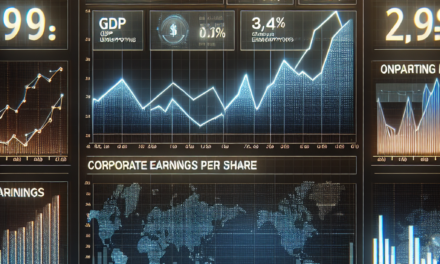“Market Whirlwind: Stocks Soar, Bonds Tumble Post-Trump Victory”
Introduction
The election of Donald Trump as the 45th President of the United States in November 2016 sent shockwaves through global financial markets, triggering a dramatic and immediate response. In the days following the election, stock markets experienced a significant surge, with major indices like the Dow Jones Industrial Average and the S&P 500 reaching record highs. Investors, buoyed by Trump’s promises of tax cuts, deregulation, and infrastructure spending, anticipated a pro-business administration that would stimulate economic growth. Conversely, the bond market faced a sharp decline, as expectations of increased government borrowing and potential inflationary pressures led to a sell-off in U.S. Treasury bonds. This divergence between equities and fixed-income securities highlighted the market’s recalibration to the anticipated policy shifts under the new administration, reflecting both optimism and uncertainty about the future economic landscape.
Analyzing Stock Market Volatility Post-Trump Election
The election of Donald Trump as the President of the United States in 2016 marked a significant turning point in the financial markets, characterized by a notable surge in stock prices and a simultaneous decline in bond values. This phenomenon can be attributed to a confluence of factors that influenced investor sentiment and market dynamics. Understanding these factors provides valuable insights into the nature of market volatility and the interplay between political events and economic expectations.
In the immediate aftermath of Trump’s election, the stock market experienced a remarkable rally, with major indices such as the Dow Jones Industrial Average and the S&P 500 reaching record highs. This surge was largely driven by investor optimism regarding Trump’s proposed economic policies, which included tax cuts, deregulation, and increased infrastructure spending. These policies were perceived as pro-business, potentially boosting corporate profits and stimulating economic growth. Consequently, investors flocked to equities, anticipating a favorable environment for businesses and a subsequent rise in stock valuations.
Moreover, the market’s reaction was also influenced by the composition of the sectors that were expected to benefit from Trump’s policies. Financial stocks, in particular, saw significant gains as investors anticipated deregulation and higher interest rates, which would enhance bank profitability. Similarly, industrial and construction-related stocks surged on the expectation of increased infrastructure spending. This sector-specific optimism contributed to the overall upward momentum in the stock market.
Conversely, the bond market experienced a sharp decline, reflecting a shift in investor expectations regarding inflation and interest rates. Trump’s proposed fiscal policies were expected to increase government spending and reduce taxes, potentially leading to higher budget deficits. This scenario raised concerns about inflationary pressures, prompting investors to demand higher yields on bonds to compensate for the anticipated erosion of purchasing power. As a result, bond prices fell, and yields rose, marking a significant divergence from the stock market’s bullish trend.
Furthermore, the Federal Reserve’s monetary policy stance played a crucial role in shaping market reactions. With the prospect of fiscal stimulus under Trump’s administration, the Federal Reserve signaled a more aggressive approach to raising interest rates to prevent the economy from overheating. This expectation of tighter monetary policy further contributed to the decline in bond prices, as higher interest rates reduce the attractiveness of fixed-income securities.
In addition to these economic factors, market psychology and behavioral finance also played a role in the observed volatility. The election of Trump, a non-traditional candidate with a controversial platform, introduced a degree of uncertainty and unpredictability into the markets. This uncertainty was reflected in increased market volatility, as investors grappled with the potential implications of Trump’s policies on both domestic and global economic landscapes.
In conclusion, the market reactions following Trump’s election underscore the complex interplay between political events, economic expectations, and investor behavior. The surge in stock prices and the decline in bond values were driven by a combination of anticipated policy changes, sector-specific optimism, and shifts in monetary policy expectations. This episode serves as a reminder of the inherent volatility in financial markets and the importance of understanding the multifaceted factors that influence investor sentiment. As such, it highlights the need for investors to remain vigilant and adaptable in the face of evolving political and economic landscapes.
The Impact of Trump’s Economic Policies on Bond Markets
The election of Donald Trump as President of the United States marked a significant turning point in the financial markets, with immediate and pronounced effects on both stocks and bonds. As investors grappled with the implications of Trump’s proposed economic policies, the stock market experienced a notable surge, while the bond market faced a sharp decline. This divergence in market reactions can be attributed to the anticipated impact of Trump’s economic agenda, which emphasized tax cuts, deregulation, and increased infrastructure spending.
To begin with, the stock market’s positive response was largely driven by investor optimism regarding Trump’s pro-business stance. His promises of substantial tax cuts for corporations and individuals were expected to boost corporate profits and consumer spending, thereby stimulating economic growth. Additionally, Trump’s commitment to deregulation was seen as a boon for industries such as finance, energy, and healthcare, which had been burdened by stringent regulatory frameworks. As a result, investors flocked to equities, driving stock prices higher in anticipation of a more favorable business environment.
Conversely, the bond market reacted negatively to the prospect of Trump’s economic policies. The anticipated increase in government spending on infrastructure projects, coupled with tax cuts, raised concerns about a widening fiscal deficit. This, in turn, led to expectations of higher inflation and interest rates, which are detrimental to bond prices. As inflation erodes the purchasing power of fixed-income returns, and rising interest rates make existing bonds less attractive compared to newly issued ones, investors began to sell off bonds, causing their prices to plummet.
Moreover, the Federal Reserve’s monetary policy stance played a crucial role in shaping bond market reactions. With the economy showing signs of strength and inflationary pressures building, the Fed signaled its intention to gradually raise interest rates. This further exacerbated the downward pressure on bond prices, as higher rates reduce the present value of future cash flows from bonds. Consequently, the bond market faced a challenging environment, with yields rising sharply in response to both fiscal and monetary policy expectations.
In addition to domestic factors, global market dynamics also influenced the bond market’s response to Trump’s election. The potential for protectionist trade policies under Trump’s administration raised concerns about global economic growth and trade relations. This uncertainty prompted a flight to safety among international investors, who sought refuge in U.S. Treasuries despite the prevailing headwinds. However, the overall trend remained bearish for bonds, as the prospect of fiscal expansion and rising interest rates overshadowed safe-haven demand.
In conclusion, the contrasting reactions of the stock and bond markets to Trump’s election can be attributed to the anticipated effects of his economic policies. While stocks surged on the back of expected tax cuts, deregulation, and infrastructure spending, bonds plummeted due to concerns about fiscal deficits, inflation, and rising interest rates. As investors navigated this new economic landscape, the interplay between fiscal policy, monetary policy, and global market dynamics became increasingly complex. Understanding these factors is crucial for market participants seeking to make informed investment decisions in the wake of significant political and economic shifts.
Investor Sentiment: Why Stocks Surged After Trump’s Victory
The election of Donald Trump as President of the United States in 2016 marked a significant turning point in global financial markets, with investor sentiment undergoing a dramatic shift. In the immediate aftermath of Trump’s victory, stock markets experienced a notable surge, while bond markets saw a sharp decline. This divergence in market reactions can be attributed to a combination of factors, including expectations of economic policy changes, investor psychology, and the broader macroeconomic environment.
To begin with, Trump’s campaign promises played a crucial role in shaping investor expectations. His proposed policies, which included tax cuts, deregulation, and increased infrastructure spending, were perceived as pro-growth measures that could potentially stimulate the U.S. economy. Investors anticipated that these policies would lead to higher corporate profits, thereby boosting stock prices. The prospect of reduced corporate taxes, in particular, was seen as a boon for businesses, as it would increase their net earnings and, consequently, their stock valuations. This optimism was reflected in the stock market’s upward trajectory following the election.
Moreover, the anticipation of deregulation under Trump’s administration further fueled investor enthusiasm. Sectors such as financial services, energy, and healthcare were expected to benefit from a rollback of regulatory constraints, which had been perceived as burdensome under the previous administration. The potential for increased profitability in these industries contributed to the bullish sentiment in the stock market. Investors were eager to capitalize on the expected regulatory relief, which was seen as a catalyst for economic growth and increased business activity.
In contrast, the bond market reacted negatively to Trump’s election, primarily due to concerns about rising inflation and interest rates. The anticipated fiscal stimulus from Trump’s proposed policies raised expectations of increased government borrowing, which could lead to higher inflationary pressures. As a result, bond investors began to demand higher yields to compensate for the expected erosion of purchasing power. This shift in expectations led to a sell-off in the bond market, causing bond prices to plummet and yields to rise.
Additionally, the Federal Reserve’s monetary policy stance played a role in the bond market’s reaction. With the economy already on a path to recovery, the prospect of further fiscal stimulus under Trump’s administration heightened expectations of more aggressive interest rate hikes by the Federal Reserve. Higher interest rates would make existing bonds less attractive, as new bonds would offer better returns. Consequently, investors began to reallocate their portfolios, moving away from bonds and into equities, which were perceived as offering better growth prospects in the new economic environment.
Furthermore, investor psychology and market dynamics also contributed to the divergent reactions in stocks and bonds. The initial uncertainty surrounding Trump’s election gave way to a “risk-on” sentiment, where investors were more willing to take on risk in pursuit of higher returns. This shift in sentiment was amplified by the so-called “Trump rally,” as market participants sought to position themselves for potential gains in a pro-business environment.
In conclusion, the surge in stock markets and the decline in bond markets following Trump’s election can be attributed to a complex interplay of factors, including expectations of economic policy changes, investor psychology, and macroeconomic conditions. The anticipation of pro-growth policies under Trump’s administration led to increased optimism in the stock market, while concerns about inflation and interest rates weighed on the bond market. As investors navigated this new landscape, their sentiment and actions reflected the broader economic and political shifts that were set in motion by Trump’s victory.
Comparing Market Reactions: Trump vs. Previous Elections
The election of Donald Trump as President of the United States in 2016 marked a significant turning point in market dynamics, eliciting reactions that were both swift and pronounced. In the immediate aftermath of Trump’s victory, the stock market experienced a notable surge, while the bond market saw a precipitous decline. This duality in market behavior was emblematic of the broader economic expectations and uncertainties that accompanied Trump’s unexpected win. To better understand these reactions, it is instructive to compare them with market responses to previous presidential elections, thereby highlighting the unique factors at play during Trump’s ascent to the presidency.
Historically, presidential elections have often been catalysts for market volatility, as investors recalibrate their portfolios in anticipation of new policy directions. However, the 2016 election was particularly distinctive due to the stark contrast between the market’s initial expectations and the eventual outcome. Leading up to the election, many investors had anticipated a victory for Hillary Clinton, which was generally perceived as a continuation of the status quo. Consequently, when Trump emerged victorious, markets were forced to rapidly adjust to the prospect of a radically different policy landscape.
In the days following Trump’s election, the stock market’s surge was driven by investor optimism regarding his pro-business agenda, which included promises of tax cuts, deregulation, and infrastructure spending. These policy proposals were seen as potentially stimulative for economic growth, thereby boosting corporate earnings and, by extension, stock prices. This optimism was particularly pronounced in sectors such as financials and industrials, which were expected to benefit directly from Trump’s policy initiatives.
In contrast, the bond market reacted negatively to Trump’s election, with bond prices plummeting and yields rising sharply. This reaction was largely attributable to concerns about increased government borrowing to finance Trump’s proposed fiscal policies, which could lead to higher inflation and interest rates. The prospect of inflation eroding the fixed returns of bonds made them less attractive to investors, prompting a sell-off. This divergence between stocks and bonds underscored the market’s complex response to the anticipated economic shifts under a Trump administration.
When comparing these reactions to those following previous elections, it becomes evident that the magnitude and direction of market movements in 2016 were somewhat atypical. For instance, the election of Barack Obama in 2008 occurred amidst the global financial crisis, leading to heightened market volatility but not the same clear-cut divergence between stocks and bonds. Similarly, the election of George W. Bush in 2000 was marked by uncertainty due to the contested results, but the market reactions were more muted and less sector-specific.
The unique market responses to Trump’s election can be attributed to several factors, including the unexpected nature of his victory, the stark contrast between his policy proposals and those of his predecessor, and the broader geopolitical uncertainties that characterized the period. These elements combined to create a market environment that was both reactive and anticipatory, as investors sought to position themselves for a new era of economic policy.
In conclusion, the market reactions following Trump’s election were emblematic of the broader uncertainties and expectations that accompanied his rise to power. By comparing these reactions to those of previous elections, it becomes clear that the 2016 election was a watershed moment in market dynamics, driven by a confluence of factors that set it apart from historical precedents. As such, it serves as a compelling case study in the interplay between politics and market behavior.
The Role of Fiscal Policy in Post-Election Market Movements
The election of Donald Trump as President of the United States in 2016 marked a significant turning point in the financial markets, with stocks surging and bonds plummeting in the immediate aftermath. This dramatic shift can be largely attributed to the anticipated changes in fiscal policy under the new administration. Investors, reacting to Trump’s proposed economic agenda, adjusted their portfolios in anticipation of a new era of fiscal policy that promised to reshape the economic landscape.
One of the primary drivers of the stock market surge was the expectation of substantial tax cuts. Trump’s campaign had emphasized reducing corporate tax rates, which investors believed would lead to increased corporate profits and, consequently, higher stock valuations. The prospect of tax reform was particularly appealing to businesses and investors, as it suggested a more favorable environment for corporate earnings growth. This optimism was reflected in the stock market, with major indices such as the Dow Jones Industrial Average and the S&P 500 experiencing significant gains in the weeks following the election.
In addition to tax cuts, Trump’s proposed infrastructure spending plan also played a crucial role in boosting investor confidence. The promise of increased government spending on infrastructure projects was seen as a potential catalyst for economic growth, as it would likely lead to job creation and increased demand for materials and services. This expectation of fiscal stimulus further fueled the stock market rally, as investors anticipated that such measures would bolster economic activity and corporate profitability.
Conversely, the bond market reacted negatively to the anticipated fiscal policies. The prospect of increased government spending and tax cuts raised concerns about rising inflation and higher interest rates. Investors feared that these policies would lead to an increase in the federal budget deficit, necessitating higher borrowing by the government. As a result, bond prices fell, and yields rose, reflecting the market’s expectation of tighter monetary conditions in the future. The sell-off in the bond market was particularly pronounced in longer-dated securities, which are more sensitive to changes in interest rate expectations.
Moreover, the anticipated shift in fiscal policy under Trump’s administration also had implications for the Federal Reserve’s monetary policy. With the potential for fiscal stimulus to boost economic growth and inflation, investors speculated that the Federal Reserve might accelerate its pace of interest rate hikes to prevent the economy from overheating. This expectation of a more aggressive monetary policy stance further contributed to the decline in bond prices, as higher interest rates would erode the value of existing bonds.
In summary, the market reactions following Trump’s election were largely driven by expectations of significant changes in fiscal policy. The promise of tax cuts and increased infrastructure spending fueled a stock market rally, as investors anticipated a more favorable environment for corporate earnings and economic growth. At the same time, concerns about rising inflation and interest rates led to a sell-off in the bond market, as investors adjusted their portfolios in response to the anticipated fiscal and monetary policy shifts. These market movements underscore the critical role that fiscal policy plays in shaping investor sentiment and financial market dynamics, highlighting the interconnectedness of economic policy and market behavior.
Sector Winners and Losers: Stock Market Trends After Trump’s Win
The election of Donald Trump as President of the United States in 2016 marked a significant turning point in the financial markets, with immediate and pronounced reactions across various sectors. In the days following the election, the stock market experienced a notable surge, while the bond market faced a sharp decline. This divergence in market behavior can be attributed to the anticipated policy shifts under the new administration, which were expected to favor certain sectors over others.
Initially, the stock market’s positive response was driven by investor optimism regarding Trump’s proposed economic policies, which included tax cuts, deregulation, and increased infrastructure spending. These policies were perceived as beneficial for corporate earnings and economic growth, leading to a rally in stock prices. In particular, sectors such as financials, industrials, and energy emerged as clear winners. Financial stocks, for instance, soared on the expectation of deregulation and higher interest rates, which would enhance profitability for banks and other financial institutions. Similarly, industrial stocks benefited from the promise of increased infrastructure spending, which was expected to boost demand for construction and manufacturing companies.
Conversely, the bond market reacted negatively to the election outcome, with bond prices plummeting and yields rising. This reaction was largely due to concerns about inflationary pressures stemming from Trump’s fiscal policies, which were expected to increase government borrowing and spending. As a result, investors anticipated higher inflation and interest rates, leading to a sell-off in bonds. The rise in bond yields also reflected expectations of a more aggressive monetary policy stance from the Federal Reserve, which would further impact bond prices.
While financials, industrials, and energy sectors thrived, other sectors faced challenges in the post-election market environment. Technology stocks, for example, experienced volatility as investors grappled with uncertainties surrounding trade policies and immigration reforms, both of which could impact the tech industry’s global supply chains and talent pool. Additionally, healthcare stocks faced pressure due to potential changes in healthcare policy, including the possible repeal of the Affordable Care Act, which created uncertainty for insurers and healthcare providers.
Despite these sector-specific trends, the overall market sentiment remained buoyant, driven by the belief that Trump’s pro-business agenda would stimulate economic growth. However, it is important to note that market reactions were not solely based on policy expectations; they were also influenced by broader economic indicators and global market dynamics. For instance, the strengthening U.S. dollar, which gained momentum following the election, had implications for multinational companies and export-driven sectors.
In conclusion, the stock market’s surge and the bond market’s decline following Trump’s election can be attributed to investor expectations of significant policy changes under the new administration. While certain sectors benefited from the anticipated economic policies, others faced headwinds due to uncertainties and potential regulatory shifts. As the market continued to adjust to the evolving political landscape, investors remained vigilant, closely monitoring policy developments and their potential impact on various sectors. This period of market adjustment underscored the complex interplay between politics and financial markets, highlighting the importance of understanding sector-specific dynamics in response to political events.
Long-term Implications of Trump’s Election on Global Markets
The election of Donald Trump as President of the United States marked a significant turning point in global financial markets, with immediate and profound reactions observed across various asset classes. In the days following the election, stock markets experienced a notable surge, while bond markets faced a sharp decline. These initial market reactions were driven by a combination of investor sentiment, policy expectations, and economic forecasts, all of which have long-term implications for global markets.
To begin with, the stock market’s positive response can be attributed to the anticipation of pro-business policies under the Trump administration. Investors were optimistic about the potential for corporate tax cuts, deregulation, and increased infrastructure spending, all of which were expected to stimulate economic growth and boost corporate profits. This optimism was reflected in the rapid rise of stock indices, with sectors such as financials, industrials, and energy experiencing significant gains. The expectation of a more business-friendly environment under Trump’s leadership fueled investor confidence, leading to increased demand for equities.
Conversely, the bond market faced a contrasting reaction, with prices plummeting and yields rising sharply. This was largely due to concerns about inflationary pressures resulting from Trump’s proposed fiscal policies. The prospect of increased government spending, coupled with tax cuts, raised fears of higher inflation, which in turn led to expectations of rising interest rates. As bond prices move inversely to yields, the anticipation of higher rates caused a sell-off in the bond market. Investors began to reassess the risk-return profile of fixed-income securities, leading to a reallocation of assets away from bonds and into equities.
Moreover, the long-term implications of Trump’s election on global markets extend beyond the immediate reactions observed in stocks and bonds. The potential shift in U.S. trade policies, with a focus on renegotiating trade agreements and imposing tariffs, introduced a new layer of uncertainty for international markets. Countries heavily reliant on trade with the United States faced the prospect of disrupted supply chains and increased costs, which could impact their economic growth and market stability. This uncertainty was further compounded by geopolitical considerations, as Trump’s foreign policy stance suggested a departure from traditional alliances and a more unpredictable approach to international relations.
In addition to trade and geopolitical factors, the long-term impact of Trump’s election on global markets also hinges on the broader economic environment. The interplay between fiscal policy, monetary policy, and global economic conditions will shape the trajectory of markets in the years to come. Central banks around the world may need to adjust their monetary policies in response to changes in U.S. fiscal policy, potentially leading to shifts in global capital flows and currency valuations. Furthermore, the sustainability of economic growth under Trump’s policies will be a critical factor in determining the long-term performance of financial markets.
In conclusion, the election of Donald Trump as President of the United States has had significant and immediate effects on global financial markets, with stocks surging and bonds plummeting in response to anticipated policy changes. While these initial reactions provide insight into investor sentiment, the long-term implications are more complex and multifaceted. As markets continue to adapt to the evolving political and economic landscape, the interplay between policy decisions, economic conditions, and investor behavior will ultimately shape the future of global markets.
Q&A
1. **Question:** What was the immediate market reaction to Trump’s election in terms of stock performance?
– **Answer:** Stocks surged immediately following Trump’s election.
2. **Question:** How did bond markets respond to Trump’s election?
– **Answer:** Bond markets plummeted after Trump’s election.
3. **Question:** Which sectors of the stock market saw significant gains post-election?
– **Answer:** Financials, industrials, and healthcare sectors saw significant gains.
4. **Question:** What was the primary reason for the surge in stock markets after Trump’s election?
– **Answer:** The surge was driven by expectations of tax cuts, deregulation, and increased infrastructure spending.
5. **Question:** Why did bond prices fall following Trump’s election?
– **Answer:** Bond prices fell due to expectations of higher inflation and increased government borrowing.
6. **Question:** How did the market’s expectations of fiscal policy change after Trump’s election?
– **Answer:** Markets anticipated more aggressive fiscal policies, including tax reforms and infrastructure investments.
7. **Question:** What was the impact of Trump’s election on the U.S. dollar?
– **Answer:** The U.S. dollar strengthened following Trump’s election due to anticipated economic growth and higher interest rates.
Conclusion
The election of Donald Trump as President of the United States led to significant market reactions characterized by a surge in stock prices and a decline in bond prices. Investors anticipated that Trump’s proposed policies, such as tax cuts, deregulation, and increased infrastructure spending, would stimulate economic growth and corporate profits, driving optimism in the equity markets. Conversely, the bond market experienced a sell-off due to expectations of rising inflation and interest rates, as these policies were also perceived to potentially increase the federal deficit. This shift in market dynamics reflected a reallocation of assets as investors adjusted their portfolios in response to the anticipated economic impact of the new administration’s policy agenda.





